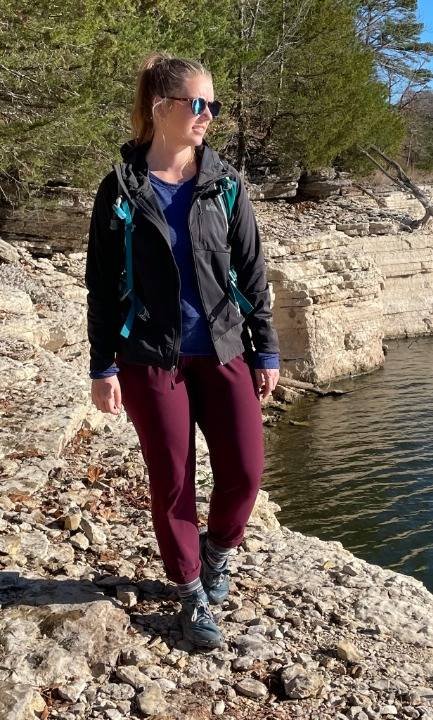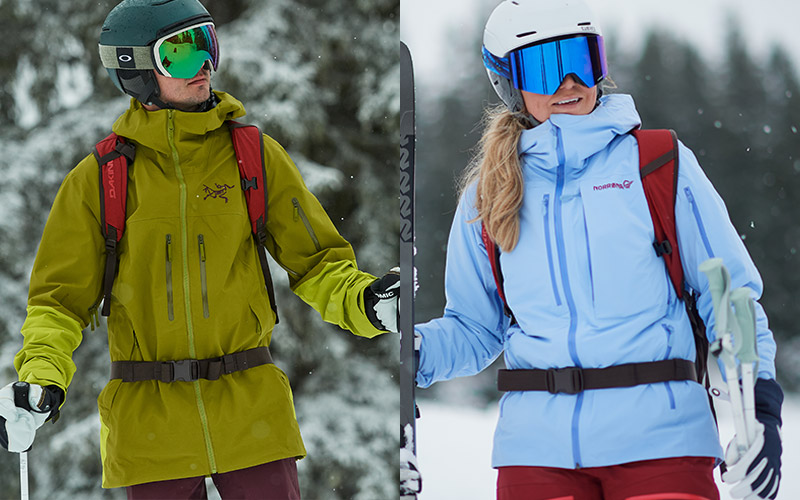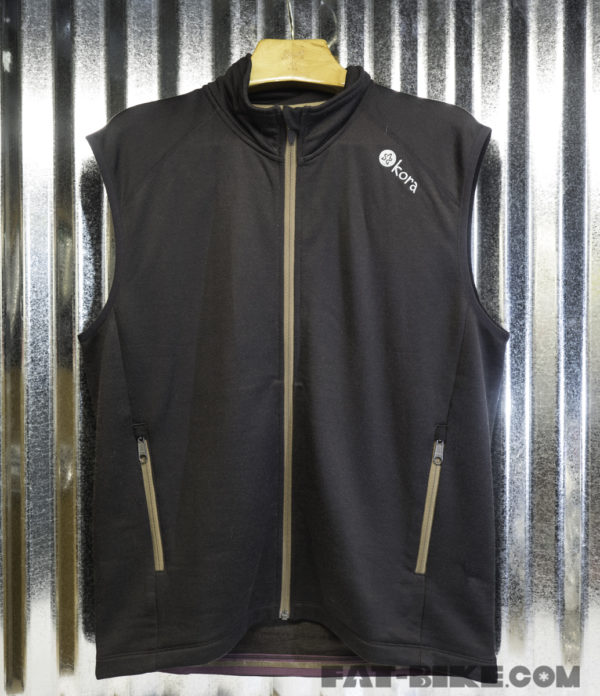When you are shopping for hiking clothing for women and men, there are several essential aspects to be considered. Here's the things you should remember: Material- Select hiking clothes constructed from quick-drying and moisture-wicking materials such as synthetic fabrics (polyester, nylon) or Merino wool. These fabrics keep you dry and comfortable by wicking sweat away and drying rapidly.
Layering- Purchase clothes that are easy to layer in order to regulate your temperature. A layering system usually consists of an inner layer that is used for water management and an insulating middle layer for warmth, and an additional layer to protect against weather.
Fit and Comfort - Choose hiking clothes that are comfortable to wear. They should permit the freedom to move without being too restrictive or loose. Take into consideration the design in order to improve mobility.
Breathability. Hiking clothes need to be breathable to ensure heat and moisture can escape. For better airflow, consider features like mesh, venting and breathable fabrics.
Moisture Management - Hiking is one of the physical exercises that may cause sweating. Select clothing that has moisture-wicking properties to remove sweat from your skin and encourage rapid drying. This can prevent irritation, chafing and moisture accumulation that could make you cold.
Weather Protection: Think about the conditions you'll be hiking in, and choose clothes that are appropriate for the conditions. To guard against rain, snow or wind you must look for waterproof outer layers. This includes rain jackets as well as pants. They provide weather protection without losing the ability to breathe.
Sun Protection - Wear clothing that has UPF (Ultraviolet protection factor) built in to protect your skin from harmful rays. Think about long-sleeved shirts, trousers, and wide-brimmed hats for additional sun protection.
Durability: Hiking exposes you to rough terrain and possible abrasion. Choose clothing made from sturdy materials and reinforced stitching that can withstand the rigors of the outdoors. It is possible to increase the longevity of your clothing by adding reinforcements at the places where they are likely to be utilized for extended periods of time, such as around the knees and elbows.
Pockets and Storage - Consider the placement and number of pockets you have in your pants, jackets, and shorts. The pockets are ample and can offer convenient storage for smaller items like a map, compass snacks, or even phones.
Versatility- Look for hiking clothes that can be worn across different seasons and various outdoor activities. Wearing clothes that are versatile lets you to maximize the use of your gear, and can reduce the requirement to buy several items that are specialized.
Fitting for gender and size-specific. Be sure to pay close attention to the sizing charts reviews, as well as other details to ensure that you pick the right size for your body. Some brands offer gender-specific fit that consider variations in body shape and proportions between women and men.
Review and Brand- Check the outdoor clothing brands you trust, known for their performance, durability and quality. To get a better understanding of the clothing's reliability and effectiveness, read customer reviews and ratings.
Budget- Set a budget for your hiking clothing as high-quality gear usually comes with a higher price tag. In the long term purchasing practical and durable clothes will be more cost-effective since it's more durable and will last longer.
When you consider these aspects, you can make informed choices when buying hiking clothes that keep you comfortable, protected, and ready for your outdoor adventures. See the top rated wool layering shirt for site advice including skiing base layer, summer wool, base layer hiking, base layer mens, kora clothes, warmest merino wool base layer and wool base layer mens.

What Do You Need To Be Aware Of About The Outer Layer/Shell Layer With Regards To Outdoor Clothes?
What you should be aware of about the outer layer or shell layer for outdoor clothes: Use. The outer layer is also called the shell, and is constructed to guard against elements like wind, rain as well as abrasions and snow. The outer layer functions as a shield between your body and external elements.
Weather Protection – The shell layer needs to provide effective weather protection for the weather conditions that you can expect. Here are some important aspects to consider:
Waterproofness - Select an outer shell that is resistant to water or waterproof. This will help keep you warm and dry during wet or snowy weather. Waterproofing materials that are commonly used include Gore-Tex or eVent as well as other membranes with waterproof properties that are proprietary to you.
Windproofness. The outer shell layer must be windproof. This will stop cold winds from getting through and taking your body heat.
Breathability. The ability to breathe in the shell layer stops moisture vapor from getting inside the garment. This regulates your body temperature to keep you comfortably cool and comfortable during workouts.
Durability The outer layer needs to be strong and durable. It must be strong enough to withstand the harsh conditions of outdoor life, such as rough terrain and abrasions caused by branches, rocks or backpacks.
Layering Compatibility: The shell should permit the insertion of layers below, such as base layers or insulating layers. It shouldn't be restrictive or too tight when worn over other garments.
Fit and adjustability. The shell layer needs to be comfortable to wear without being too bulky or overly loose. Features that can be adjusted, such as hoods, cuffs, and hem drawcords can help seal out the elements and permit a customized fitting.
Hood and Collar- A well-designed hood with adjustable adjustments and a collar that is high helps to shield your neck and head from the elements of wind, rain and cold. Choose an hood that provides sufficient coverage and can be adjusted to provide optimal visibility and safety.
Ventilation and Pockets- Designed pockets in the shell layer work for storage, and also provide access to the essentials. Ventilation options, such as mesh-lined pockets or pit zips help regulate the body's temperature in high-intensity workouts.
Weight and Packability If you are planning to carry the shell layer in a bag, consider the ability to pack it and its weight. For outdoor activities, light and compact layers are best.
Care and Maintenance Follow the maintenance and care guidelines from the manufacturer to maintain the performance and durability of the shell. Make sure to regularly clean and reproof your shell layer with appropriate products to maintain its breathability and waterproofness.
Consider these factors when choosing an outer shell or layer that will give you protection from weather and comfort during outdoor activities. View the most popular hooded anorak women's for more examples including best merino wool base layers, base layer hiking, wool base layer, merino wool blend, how to layer for skiing, hiking layers and best mid layer for skiing.

What Are The Main Differences Between Clothing For Outdoor Use And Weather-Specific Clothing?
Specificity of the weather and activities is a major consideration when selecting outdoor clothing. Here's what you should know: Different conditions in the weather demand various materials and features for outdoor clothing. Take into consideration the following aspects:
Temperature- Select clothing that is insulated enough for the expected temperature range. Layering allows you to alter levels of insulation according to temperature.
If it's snowing, raining, or drizzleing, outer layers with waterproof membranes or seams sealed will keep you dry. Look for clothes with waterproof membranes or seams.
Wearing clothing that is windproof will prevent cold air from entering and stealing body heat. You should look for materials that are wind resistant and come with features such as adjustable hoods, cuffs, and cuffs.
Sun Exposure. When it is sunny wear clothing that has UV protection ratings, also known as UPFs (Ultraviolet Protection Factors), will protect your body from harmful rays of the sun.
Activity Level- The level of physical activity impacts your clothing choices. Take note of the following factors:
Breathability. When you are working out at a high intensity wearing clothing that is ventilated will help to keep sweat away and help you stay at ease. Choose fabrics that are moisture wicking and ventilation options like pit zips or mesh panels.
Mobility-Activities that require extreme movement, like climbing or hiking, need clothing that offers unrestricted mobility. Find clothing that has stretch panels or articulated joints.
Durability- Consider the demands that your sport puts on your clothes. If you are a fan of bushwhacking or rough activities, choose clothing constructed of tough fabrics. They can withstand abrasions, wear and tear.
Layering System for Layering. A layering system allows you to adapt your clothing according to the weather and your activity. Consider the air-flow, insulation and weather protection of your base, mid and outer layers.
Specialized Gear- Some activities might require special gear. For example,
Winter Sports: Skiing and snowboarding are both winter sports that require specific attire to shield against snow, provide protection against the elements and to ensure waterproofness.
Water Activities - Clothing with water-resistant and quick-drying properties is necessary for water-based activities such as kayaking, paddleboarding or sailing.
Climbing at High Altitudes- When climbing at high altitudes it is essential to wear clothing that will keep you warm, protect against wind and breathability in extreme conditions.
The ability to dress in layers gives you to regulate your the body temperature, depending on your activity level and weather conditions. By adding or taking off layers, you can ensure comfort while preventing overheating and hypothermia.
Seasonal Considerations- Different seasons might require changes to your wardrobe options. Be aware of changes in weather conditions, such as temperature and precipitation.
Local Conditions - Take into consideration the climate and weather patterns that are prevalent in your area of. Consult local weather forecasts to get an idea of what you need.
When you consider the weather conditions and other particulars, you can pick the appropriate gear and clothing that will enhance your comfort, safety, and performance on outings. Prioritize features such as insulation, breathability, weather protection, and mobility to be prepared for any weather conditions. Read the most popular kora mens for blog recommendations including yak clothing, kora green, best base layer for skiing, wool baselayer, merino wool blend, wool shirt men and merino wool base layer pants.

What Should I Know About Wool Vests, Tank Tops, Jackets, And The Hats To Wear For Skiing And Hiking?
There are a few things to consider when buying wool clothing like jackets and vests. You should be aware of the following:- Material- Wool clothing like jackets, tanks, vests and hats are constructed using different kinds of wool. This includes the merino. Merino wool is a favorite for outdoor pursuits because of its softness, moisture-wicking properties, breathability, and odor resistance. For optimal performance, look for clothing made of wool that is top-quality.
Wool provides excellent insulation even after it becomes wet. It wicks away heat by capturing the air inside its fibers. It's ideal to use for skiing or hiking in colder temperatures. Consider the desired temperature range and your personal comfort preferences.
Layering- Wool vests, tanks tops, jackets and hats are frequently employed as an element of a layering system. They can be worn as an outer or an inner layer, depending on the weather. It is easy to regulate the temperature during your hiking or skiing excursion by layering.
Moisture Management - Wool's inherent characteristics of wicking moisture help it absorb sweat and then transport it away from your body. During physical activity This helps you stay dry and comfy. Wool clothes can hold warmth even when they are damp.
Breathability: Wool is breathable by nature, which allows air to circulate and allows heat to escape. This assists in regulating body temperature and prevents overheating during intense activities. Wool garments, especially ones that have a looser weave or ventilation features, offer greater airflow to allow for improved breathability.
Wool's antimicrobial qualities help stop the growth of bacteria that cause odor. Wool garments - vests, jackets, tank tops and hats - are able to last longer, even after extended usage. Wool garments are much less difficult to wash than synthetic materials. They are perfect for longer trips.
Wool clothing, specifically those made of merino, is known for their softness and the comfort it provides. They do not have the itchiness that is commonly associated with coarser wool varieties, making them suitable for skin that is sensitive.
DurabilityWool is a tough and long-lasting fabric if cared for properly. Wool clothing should be reinforced stitching, and should be made of high-quality materials that can withstand hiking and skiing. Be sure to follow the instructions of the manufacturer for washing and storage will maintain their performance.
Design and Fit- Take into consideration the fit and the design of the wool garments so that they provide comfort and functionality. Find features like zippered pockets, adjustable hoods and stretch panels to ensure the ease of movement and comfort when you are outdoors. Choose sizes which allow you the possibility of layering under while still providing comfort.
UV Protection: Wool provides a certain level of UV resistance. If you're planning to spend time in the sun for long duration, for example, while hiking or skiiing and skiing, it's best to pair wool with other sun protection measures like sunglasses, sunscreen and a hat with an extended brim.
Wool clothes are available in different styles, colours, and designs. When picking out vests and tank tops for outdoor activities, think about your personal style as well as your particular outdoor requirements. Choose pieces that are able to be mixed and matched.
Always think about your specific hiking and skiing needs, including weather conditions and the intensity of your activity, and even individual preferences when selecting wool jackets. If you select wool clothes of the highest quality and making them part of a thoughtful layers system, you will stay comfortable and warm. See the most popular gaiter hat for website advice including mens merino wool thermals, best mid layer for hiking, best thermals for men, thermal base layers, wool vest, skiing base layers and yak clothing.

